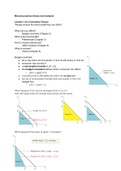Samenvatting
Samenvatting Microeconomics: theory and analysis
- Instelling
- Tilburg University (UVT)
College aantekeningen, met slides en eventuele extra notities en berekeningen van het van Microeconomics: theory and analysis Dit bevat alle stof die je moet kennen voor dit vak, het 'kunnen' gedeelte zit hem vooral in de instructie- en werkcolleges. Voor dit vak zijn de instructiecolleges en we...
[Meer zien]




